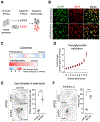APOE4 disrupts intracellular lipid homeostasis in human iPSC-derived glia
- PMID: 33658354
- PMCID: PMC8218593
- DOI: 10.1126/scitranslmed.aaz4564
APOE4 disrupts intracellular lipid homeostasis in human iPSC-derived glia
Abstract
The E4 allele of the apolipoprotein E gene (APOE) has been established as a genetic risk factor for many diseases including cardiovascular diseases and Alzheimer's disease (AD), yet its mechanism of action remains poorly understood. APOE is a lipid transport protein, and the dysregulation of lipids has recently emerged as a key feature of several neurodegenerative diseases including AD. However, it is unclear how APOE4 perturbs the intracellular lipid state. Here, we report that APOE4, but not APOE3, disrupted the cellular lipidomes of human induced pluripotent stem cell (iPSC)-derived astrocytes generated from fibroblasts of APOE4 or APOE3 carriers, and of yeast expressing human APOE isoforms. We combined lipidomics and unbiased genome-wide screens in yeast with functional and genetic characterization to demonstrate that human APOE4 induced altered lipid homeostasis. These changes resulted in increased unsaturation of fatty acids and accumulation of intracellular lipid droplets both in yeast and in APOE4-expressing human iPSC-derived astrocytes. We then identified genetic and chemical modulators of this lipid disruption. We showed that supplementation of the culture medium with choline (a soluble phospholipid precursor) restored the cellular lipidome to its basal state in APOE4-expressing human iPSC-derived astrocytes and in yeast expressing human APOE4 Our study illuminates key molecular disruptions in lipid metabolism that may contribute to the disease risk linked to the APOE4 genotype. Our study suggests that manipulating lipid metabolism could be a therapeutic approach to help alleviate the consequences of carrying the APOE4 allele.
Copyright © 2021 The Authors, some rights reserved; exclusive licensee American Association for the Advancement of Science. No claim to original U.S. Government Works.
Conflict of interest statement
Figures




Similar articles
-
APOE2, E3, and E4 differentially modulate cellular homeostasis, cholesterol metabolism, and inflammatory response in isogenic iPSC-derived astrocytes.Stem Cell Reports. 2022 Jan 11;17(1):110-126. doi: 10.1016/j.stemcr.2021.11.007. Epub 2021 Dec 16. Stem Cell Reports. 2022. PMID: 34919811 Free PMC article.
-
Sex-dependent calcium hyperactivity due to lysosomal-related dysfunction in astrocytes from APOE4 versus APOE3 gene targeted replacement mice.Mol Neurodegener. 2020 Jun 9;15(1):35. doi: 10.1186/s13024-020-00382-8. Mol Neurodegener. 2020. PMID: 32517777 Free PMC article.
-
Differential Signaling Mediated by ApoE2, ApoE3, and ApoE4 in Human Neurons Parallels Alzheimer's Disease Risk.J Neurosci. 2019 Sep 11;39(37):7408-7427. doi: 10.1523/JNEUROSCI.2994-18.2019. Epub 2019 Jul 22. J Neurosci. 2019. PMID: 31331998 Free PMC article.
-
Multiple Roles of Apolipoprotein E4 in Oxidative Lipid Metabolism and Ferroptosis During the Pathogenesis of Alzheimer's Disease.J Mol Neurosci. 2024 Jul 3;74(3):62. doi: 10.1007/s12031-024-02224-4. J Mol Neurosci. 2024. PMID: 38958788 Free PMC article. Review.
-
Alzheimer's disease phenotype based upon the carrier status of the apolipoprotein E ɛ4 allele.Brain Pathol. 2024 Jan;34(1):e13208. doi: 10.1111/bpa.13208. Epub 2023 Aug 30. Brain Pathol. 2024. PMID: 37646624 Free PMC article. Review.
Cited by
-
TRPV1 alleviates APOE4-dependent microglial antigen presentation and T cell infiltration in Alzheimer's disease.Transl Neurodegener. 2024 Oct 29;13(1):52. doi: 10.1186/s40035-024-00445-6. Transl Neurodegener. 2024. PMID: 39468688 Free PMC article.
-
Lipid Trajectories Improve Risk Models for Alzheimer's Disease and Mild Cognitive Impairment.medRxiv [Preprint]. 2024 Sep 28:2024.09.27.24314494. doi: 10.1101/2024.09.27.24314494. medRxiv. 2024. PMID: 39399044 Free PMC article. Preprint.
-
Metabolic Reprogramming of Astrocytes in Pathological Conditions: Implications for Neurodegenerative Diseases.Int J Mol Sci. 2024 Aug 16;25(16):8922. doi: 10.3390/ijms25168922. Int J Mol Sci. 2024. PMID: 39201607 Free PMC article. Review.
-
APOE ε4-associated downregulation of the IL-7/IL-7R pathway in effector memory T cells: Implications for Alzheimer's disease.Alzheimers Dement. 2024 Sep;20(9):6441-6455. doi: 10.1002/alz.14173. Epub 2024 Aug 11. Alzheimers Dement. 2024. PMID: 39129310 Free PMC article.
-
Proteogenomic network analysis reveals dysregulated mechanisms and potential mediators in Parkinson's disease.Nat Commun. 2024 Jul 31;15(1):6430. doi: 10.1038/s41467-024-50718-x. Nat Commun. 2024. PMID: 39080267 Free PMC article.
References
-
- Fanning S, Haque A, Imberdis T, Baru V, Barrasa MI, Nuber S, Termine D, Ramalingam N, Ho GPH, Noble T, Sandoe J, Lou Y, Landgraf D, Freyzon Y, Newby G, Soldner F, Terry-Kantor E, Kim TE, Hofbauer HF, Becuwe M, Jaenisch R, Pincus D, Clish CB, Walther TC, Farese RV, Srinivasan S, Welte MA, Kohlwein SD, Dettmer U, Lindquist S, Selkoe D, Lipidomic Analysis of α-Synuclein Neurotoxicity Identifies Stearoyl CoA Desaturase as a Target for Parkinson Treatment, Mol. Cell 73, 1001–1014.e8 (2019). - PMC - PubMed
-
- Marschallinger J, Iram T, Zardeneta M, Lee SE, Lehallier B, Haney MS, V Pluvinage J, Mathur V, Hahn O, Morgens DW, Kim J, Tevini J, Felder TK, Wolinski H, Bertozzi CR, Bassik MC, Aigner L, Wyss-Coray T, Lipid-droplet-accumulating microglia represent a dysfunctional and proinflammatory state in the aging brain, Nat. Neurosci 23, 194–208 (2020). - PMC - PubMed
-
- Hamilton LK, Dufresne M, Joppé SE, Petryszyn S, Aumont A, Calon F, Barnabé-Heider F, Furtos A, Parent M, Chaurand P, Fernandes KJL, Aberrant Lipid Metabolism in the Forebrain Niche Suppresses Adult Neural Stem Cell Proliferation in an Animal Model of Alzheimer’s Disease, Cell Stem Cell 17, 397–411 (2015). - PubMed
Publication types
MeSH terms
Substances
Grants and funding
LinkOut - more resources
Full Text Sources
Other Literature Sources
Medical
Research Materials
Miscellaneous

